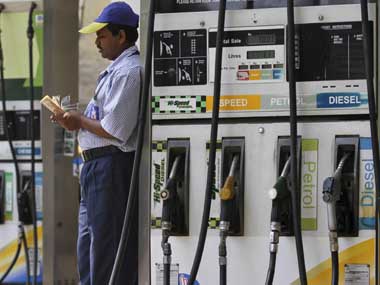Petroleum Minister Jaipal Reddy told newspersons on Wednesday that the government will try to limit the subsidy paid by state-run exploration and production companies (ONGC, Gail and Oil India) to one-third of the total losses of the oil marketing companies like Indian Oil, HPCL and BPCL. If Reddy is able to get Pranab Mukherjee to sign on the dotted line on this, it can mean that another oil price hike will have to pushed through this year. Alternatively, Mukherjee will have to borrow even more to pay subsidies to the marketing companies. ONGC, Gail, and Oil India sell crude oil and products to the marketing firms at a discount to partially compensate them for losses. The government had raised the share of their subsidy to 38.7 percent for the March quarter from 33.33 percent earlier. If it now reverts back to 33.3 percent, it could mean either price increases or larger government borrowings. [caption id=“attachment_111946” align=“alignleft” width=“380” caption=“The dilemma is clear: if the finance ministry borrows more to give oil companies the subsidies due to them, it will keep interest rates rising for some more time and slow down GDP growth. Reuters.”]  [/caption] A few weeks ago, the finance ministry shocked the markets by announcing that it will be borrowing Rs 53,000 crore more than what was budgeted due to poor cash flows. Another increase in borrowing programmes will send interest soaring higher. The oil companies are already deep in the red, and the finance ministry has been delaying the payment of subsidies for the first half of the year – forcing them to borrow more at high rates. At current oil prices and currency rates, the oil companies expect to lose over Rs 1,20,000 crore in 2011-12. The dilemma is clear: if the finance ministry borrows more to give oil companies the subsidies due to them, it will keep interest rates rising for some more time and slow down GDP growth. Pranab Mukherjee has already acknowledged that growth is slowing, and most economists think growth will fall below 8 percent this year. On the other hand, if subsidies payable by ONGC and other production companies are not capped, chances of raising money from ONGC disinvestment will disappear. The only way out is to raise petro-prduct prices, especially diesel, on which the oil companies currently lose nearly Rs 7 per litre. An increase in diesel prices or total price deregulation will have the negative effect of boosting inflation in the short-term, since diesel accounts for nearly 5 percent of the Wholesale Price Index. But inflation is anyway not under control. It’s a lost cause for now. Reddy’s comment, that the subsidies payable by ONGC will be capped at 33.3 percent, could be a hint that the government may be finally ready to bite the bullet on diesel price increase. The cabinet could also decide to limit the number of subsidised cooking gas cylinders to four a year. So, get ready for another stiff hike in oil prices later this year.
Reddy’s comment, that the subsidies payable by ONGC will be capped at 33.3 percent, could be a hint that the government may be finally ready to bite the bullet on diesel price increase.
Advertisement
End of Article


)
)
)
)
)
)
)
)
)



